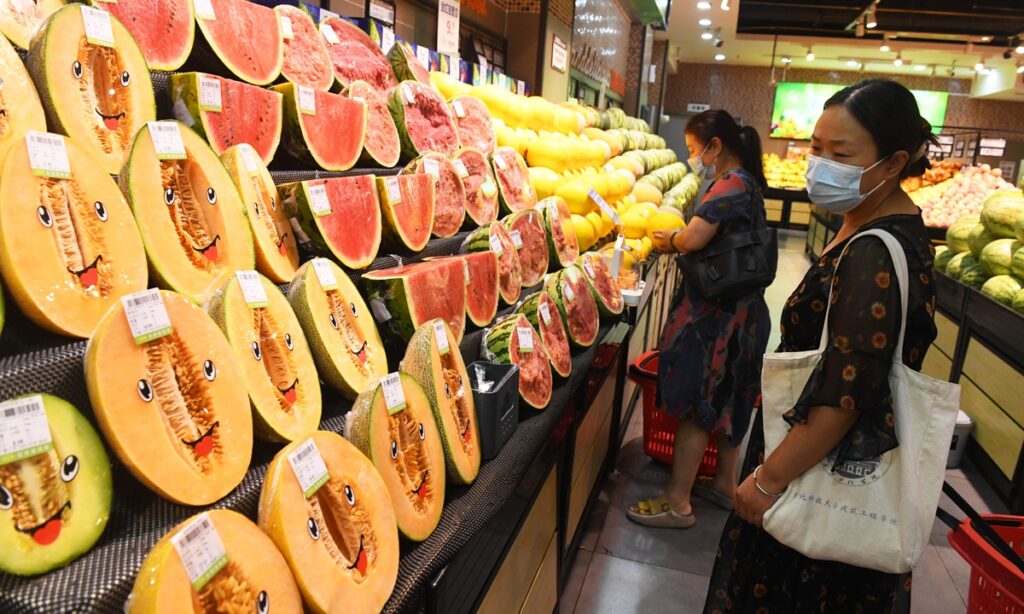China’s consumer price index (CPI), a main gauge of inflation, fell in July for the first time in more than two years, as widely expected by the market.
Analysts said that the index has hit its low for this year and will steadily climb in the coming months with consumer demand on the rise.
The CPI edged down 0.3 percent on a yearly basis in July, while the factory-gate prices of bulk commodities posted a narrowed decline, the National Bureau of Statistics (NBS) said on Wednesday.
Prices of vegetables and pork, the two major items that influence food prices, fell in July, driving food prices down 1.7 percent on a yearly basis.
Pork prices tumbled 26 percent year-on-year, 18.8 percentage points faster than the fall in June, while prices of fresh vegetables fell 1.5 percent compared with a 10.8 percent surge in June, the NBS data showed.
The core CPI, deducting food and energy prices, rose 0.8 percent year-on-year, with the pace of increase up 0.4 percentage points compared with June.
Among non-food items, prices for tourism, which is experiencing its summer peak, rose 13.1 percent in July, accelerating 6.7 percentage points from June’s growth rate.
The CPI decline on a yearly basis mainly reflected the high base of comparison in 2022, NBS statistician Dong Lijuan said in a statement.
“Overall, the CPI decline is a phased thing. In the next stage, with China’s economic recovery picking up momentum and market demand steadily expanding, coupled with the gradual erasing of the high base effect last year, the index will climb,” Dong said.
Consumer prices rose 0.2 percent month-on-month in July, underscoring the continued recovery of consumer demand.
Weak price data since the start of the second quarter has raised market concerns about deflation that could harm the recovery of the world’s second-largest economy.
But experts said there’s no deflation risk on a full-year basis, with consumer prices expected to rise in the third quarter as policy stimulus reinvigorates consumption.
Wang Qing, chief macroeconomic analyst at Golden Credit Rating International, told the Global Times on Wednesday that the CPI’s fall in July was most likely a temporary phenomenon against the backdrop of a sustainable economic recovery and double-digit growth of M2 money supply.
M2, which covers cash in circulation and all deposits, was up 11.3 percent year-on-year to 287.3 trillion yuan ($39.9 trillion) at the end of June, according to the People’s Bank of China, the country’s central bank.
Wu Chaoming, a deputy head of the Chasing Research Institute, told the Global Times on Wednesday that the July CPI reading will be the lowest point of the year.
A recovery of energy prices and the stabilization of pork prices will drive up the year-on-year growth of the CPI.
However, Wu noted that it’s still possible the CPI will fall year-on-year again in August and September, mainly due to the high base in the third quarter of 2022.
Wang said that the full-year CPI could return to the normal level of around 2 percent growth by year-end.
The average CPI during the first seven months increased by 0.5 percent year-on-year, according to the NBS data.
Experts and research institutions refuted claims hyped by Western media, which compared China’s current low inflation to Japan’s “lost decades” since the 1990s, when consumer prices stagnated for a long period.
Japan’s long-term recession was characterized primarily by mild sustained deflation, but there’s currently no basis for long-term deflation in China, according to an analysis by China Securities.
China’s CPI growth in the services industry has been higher than that of Japan for a long time, which is similar to the trend in the US.
In demographic terms, China’s population aging has not reached the depth of Japan’s, so the drag on wages and consumption is not obvious, the note said.
NBS spokesperson Fu Linghui said previously that there were multiple reasons for the weak CPI, including a complex and severe international environment, sluggish world economy, insufficient domestic demand and a relatively high year-earlier base. He stressed that the weakness is temporary.
The NBS also announced on Wednesday that the July producer price index (PPI), a main gauge of factory prices, fell 4.4 percent year-on-year – the 10th consecutive monthly decline. But the decline narrowed for the first time in seven months.
In June, the PPI hit the lowest point since 2016 with a decline of 5.4 percent.
The narrowed declines of the PPI on both a monthly and a yearly basis mean that there’s sufficient domestic supply, improved demand in some industries and firming prices for such bulk commodities as oil and coal, Dong said.
(Global Times)




